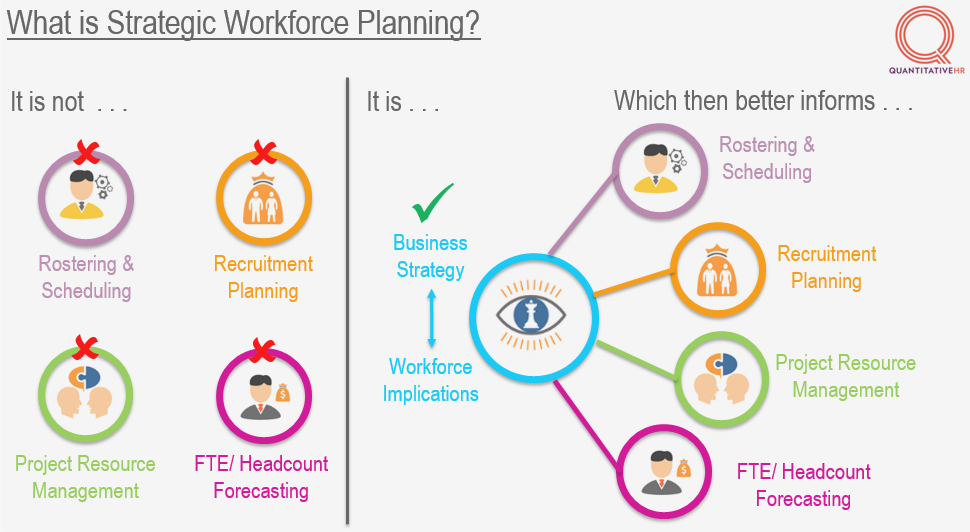Everyone’s Doing SWP
Strategic Workforce Planning – Everyone’s Doing It . . . Or Are They???
Strategic Workforce Planning (SWP) – it has to be amongst the most misused, least understood business phrases out there. Ask five different people what SWP is to them and you will end up with seven different answers. Responses may range from rostering, project management, and recruitment pipelining to financial headcount forecasting. They have Sarah from Operations, Joanne from Finance and Tom from Sourcing “doing SWP” – they have it covered.
Whilst in truth SWP provides input into each of those elements, it is much more than the sum of those parts. At the heart of SWP is the translation of business strategy into workforce implications – in a quantitative way. What does this mean? Working out what your business is trying to achieve and making sure it has the workforce it needs to do it. Identifying the gaps and overlaps provides your HR function with a clear mandate and the imperative to make this happen!
At the core of SWP, in translating the business strategy into workforce implications, is building a future view of workforce DEMAND. And this, in my opinion, is where pretty much most efforts fall short. I am yet to see many who do this well. Books, literature and even standards in SWP are relatively vague and conceptual, or at best linear, assuming some static ratio to revenue growth or decline. Beyond oversimplification, this wrongly assumes companies have the right workforce in place to start with. In other cases, determining demand is conceptual, based on discussions with various parties around the organisation then rolled into a single view (which usually is WAY over the Finance numbers, and has little rigour in how the numbers were arrived at – finger in the air anyone???)
SWP is powerful only when it interprets business strategy through the lens of critical success factors, business drivers, activities and variables that impact on future workforce demand for each workforce segment. These factors are unique for each and every business, and each and every labour segment (and hence why it is extremely difficult to get the right off-the-shelf software to do this for you!). This demand element is what then provides context for everything else – the internal workforce supply, the external workforce demand and supply. Yes, we may be turning over 40% of workforce XYZ per annum, but we do not need to focus on that because our business is demand for that skill is declining anyway. Yes, there may be a shortage of skilled engineers in Adelaide, but we are looking to shut down our Adelaide site in 2 years anyway. However, we are increasing our digital presence so what shape and size workforce do we need there, and from where do we source that capability? Without understanding what your business actually requires through articulating demand, other factors are just pieces of information with little business relevance.
I recently had a very senior executive of a large ASX listed company say to me “well what’s the point of creating models, things are going to change anyway and then it will be wrong”. As one of the great statistical minds of the 20th century, George Box, said “all models are wrong, some are useful”. My response would be to say that at least by planning for the future, as things invariably change, you have a baseline from which to understand that change and you are not flying blind. And this is absolutely the greatest power of SWP. The power of decision scenarios as a critical strategic business tool. Take the case of Royal Dutch Shell Group of companies. Their system of scenario planning is acknowledged to be one of the best strategic planning systems used today and has been credited for turning around its business performance. At Shell, planning for the future is done through scenarios, which not only enables superior decision making, but also facilitates alignment between management teams who are all perceiving things through their own lens. As in Synchronicity by Joseph Jaworski, “a managers’ inner model never mirrors reality . . . it is always a construct. The scenario process is aimed at these perceptions inside the mind of a decision maker. By presenting other ways of seeing the world, decision scenarios give managers something very precious: the ability to re-perceive reality, leading to strategic insights beyond the minds reach”.
Scenario planning, such as what SWP delivers, takes organisations out of the past and present and gets them looking to the future – really shifts them from being reactive to proactive. This brings insight, focus and alignment to management teams, who are usually perceiving issues differently; Operations needs resources to deliver, Finance with its cost focus and HR with its drive to increase capability and development. SWP brings together an informed view of business strategy versus the workforce, integrating all elements in a dynamic and predictive construct to centre the conversation on strategy, planning and ACTION. SWP creates the alignment of the business with HR and with Finance. It provides a quantitative basis for understanding the workforce and facilitates great discussions. I have been in rooms of large listed companies where the dialogue from SWP has uncovered misalignment in business direction between a CEO, COO and CFO – and then brought them back together, with clarity on the achievability of the strategy. And HR is the function that has executed an initiative centralising conversations, influencing the business strategy and creating the business case for workforce action – now that is mighty stuff!
Stay tuned for more about Strategic Workforce Planning in upcoming posts, including the elements of the QHR SWP framework and Case Studies from Companies who have successfully embedded SWP as part of their core business and HR processes.

